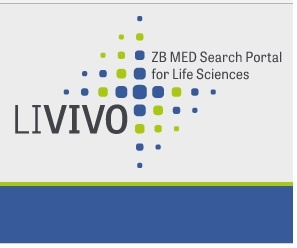LIVIVO : the Search Portal for Agricultural and Environmental Sciences, Medicine, and Health


(Sources: LIVIVO search portal & LIVIVO : Vertical Search Engine for Life Sciences)
The search terms in LIVIVO are automatically linguistically enriched and semantically linked by vocabularies that are specially designed and adapted for life sciences, - using MeSH - for medical sciences , UMTHES - for environmental sciences and AGROVOC - for agricultural sciences. This leads to precise and enhanced search results - a hit list that is sorted by relevance and can be filtered by the ZB MED subjects fields : medicine/health, nutrition, environment and agriculture.
_________________________________________________________________________________________________________________
The LIVIVO interdisciplinary search engine is developed in-house by ZB MED Information Centre for Life Sciences. ZB MED is an independent, public foundation that is financed by means of the federal government and the individual state governments. In the more than 40 years of its existence it has become the worlds largest special library with the combination of the scientific subjects medicine, health, nutrition, environmental and agricultural sciences.
_________________________________________________________________________________________________________________
LIVIVO user-friendly and usability-tested search interface has a corpus of about 65 Million citations derived from more than 50 databases.
The records found can be * ordered from the stock of ZB MED, * accessed directly online or * ordered through the document delivery service of ZB MED.
Semantic search technology
LIVIVO uses an index-based search engine with a specially developed search technology that empowers retrieval functionality by incorporating various literature resources with only one search request.
This means that multiplicity of data sources (such as library catalogues, databases or publisher directories) are being searched simultaneously. LIVIVO includes a complete PubMed-search and other important databases in life sciences such as AGRICOLA or AGRIS.
The search terms are automatically linguistically enriched and semantically linked by vocabularies that were specially designed and adapted for life sciences: AGROVOC multilingual Thesaurus of FAO of the UN - for agricultural sciences, MeSH (Medical Subject Headings) - for medical sciences, and UMTHES - for environmental sciences. This leads to precise and enhanced search results.
The service oriented architecture of LIVIVO uses four different implementation layers to deliver search services. A Knowledge Environment (KE) is developed by ZB MED to deal with the heterogeneity of data as an integrative approach to model, store, and link semantic concepts within literature resources and databases.
The ZB MED KE is built upon Open Source-Databases (SOLR, Neo4j, MongoDB), Open Source-Frameworks (UIMA) and Linked Open Data-Sets (MeSH, AGROVOC, DrugBank), literature resources with metadata and full-texts that are annotated using a UIMA-based text and data mining workflow. |
The result is a hit list that is sorted by relevance (learn more about our relevance ranking) and can be filtered by the ZB MED subjects fields medicine/health, nutrition, environment and agriculture.
# Learn more about LIVIVO services combined with useful features |
"Ontological relationships amongst the semantic entities are preserved by using the graph database Neo4j. The ontological information is derived from the MeSH tree, the Anatomical Therapeutic Chemical classification system (ATC) for pharmaceuticals (in DrugBank) and the AGROVOC tree [that offers an ontological representation of agricultural and agriculture related concepts].
The ontological structure of semantic entities enables functionalities like query expansion, the aggregation of search results, and concept- based ranking algorithms", - Beyond Metadata - Enriching Life Science Publications in LIVIVO with Semantic Entities from the Linked Data Cloud (PDF).
Future work will focus on the exploitation of life science ontologies and on the employment of NLP technologies in order to improve query expansion, filters in faceted search, concept based relevancy rankings in LIVIVO and ... multilingualism in the corpus of LIVIVO as a multilingual search engine.
Dictionaries with concepts as well as relations of concepts are derived from MeSH, AGROVOC, and DrugBank (using ATC). Natural language processing (NLP) is required for translating search queries into the respective document languages. Search terms have to be translated into concepts of multilingual thesauri such as AGROVOC that has translations in about 30 languages (see: AGROVOC terms in SKOSMOS) or MeSH that has translations into English, German, Chinese, and other languages.
Considering that ATC, MeSH and AGROVOC are available as linked open data (see: The Linking Open Data cloud diagram), there is an overlap with other existing knowledge bases, also because of the intersection of the modeled domain with generic views or certain processes.
# LIVIVO Text Mining Data (see: DataHub) generated with UIMA ConceptMapper using MeSH, DrugBank, and AGROVOC on LIVIVO corpus with 63 Million citations. |
# The word cloud prototype is developed for LIVIVO underlying statistics for the concepts are calculated on the corpus of 55 Million citations from LIVIVO. |
Big data analysis is conducted on the ZB MED KE that is transferred into LIVIVO as potentially novel visualization techniques.
Sources:
- LIVIVO : The Search Portal for Life Sciences
- LIVIVO – the Vertical Search Engine for Life Sciences (SpringerLink, 2017)
____________________________________________________________________________________________________________
- Linked Biomedical Dataspace: Lessons Learned integrating Data for Drug Discovery
- Enabling Multilingual Search through Controlled Vocabularies: the AGRIS Approach (Metadata and Semantics Research: 10th International Conference, MTSR 2016)
- An update on AGROVOC web services
- AGROVOC in AgroPortal
- Register to AGORA (Access to Global Online Research in Agriculture) and start using its content [4 July : New Authentication System for AGORA login "goes-live" online]
- Survey on usability of AGROVOC Thesaurus and its services

